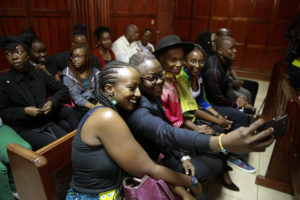Jabari Asim: Bone-Deep Similarities
Recent anthropological research suggests that our African and Eurasian ancestors were more genetically similar than we had thought.WASHINGTON — In “Between the World and Me,” Richard Wright’s classic poem, a traveler stumbles upon a skull half-hidden in the grass. In a frightening whirlwind of soot and magic, the wanderer learns about the man to whom the skull belonged, how he lived and died. “The dry bones stirred, rattled, lifted, melting themselves into my bones,” the narrator recalls. “The grey ashes formed flesh firm and black, entering into my flesh.”
Frederick E. Grine’s encounter with a pivotal skull was far less dramatic. The anthropologist initially spotted it resting on a colleague’s shelf in Cape Town, South Africa. But, when studying bones and fossils, scientists such as Grine often pose the same questions suggested by Wright’s poem: Who was this man? How did he spend his days? How long ago did he live? What Grine learned from that skull on the shelf, recently published in the journal Science, goes beyond providing clues to a single individual’s existence. It also tells us much about humans’ epic journey from Africa to the rest of the world.
The skull, found 50 years ago in Hofmeyr, South Africa, initially confounded attempts to establish its age. But new techniques show that it is roughly 36,000 years old. Grine and his team of researchers at the State University of New York at Stony Brook have concluded that the skull confirms prevailing theories about human origins in sub-Saharan Africa. Three-dimensional measurements indicate that the skull is more anatomically and genetically similar to skulls of humans found in Later Stone Age Europe than those found in modern-day South Africa. According to Grine’s team, such findings suggest that “humans like those that inhabited Eurasia should be found in sub-Saharan Africa around 36,000 years ago.”
Debates about the origin of human species have been pretty much settled; most experts now agree that it all began in Africa. What they argue about these days is whether ancient Europeans and Asians had contact with other variations of early hominids and became somehow different from the folks in Africa. This skull and other evidence suggest otherwise.
Although I read about the recent findings with interest, I confess to reading anything about skulls and race with a large measure of skepticism, perhaps a larger portion than is deserved. That’s because the scientific study and measurement of skulls, called craniometry back in the 19th century, has dubious roots. Back then, scientists relied on their “findings” to argue in favor of white supremacy. Chief among them was Samuel George Morton, a graduate of the University of Pennsylvania Medical School and owner of a skull collection so vast that his lab was nicknamed the American Golgotha.
In 1839 Morton set out to assess intelligence by measuring cranial capacities. He published his findings in an influential book called “Crania Americana.” He studied the skulls of five “races” — Caucasian, Mongolian, Malay, American and Ethiopian — and found that Caucasians were most intelligent. Least so, according to Morton, were Ethiopians, whose skulls suggested that they were “the lowest grade of humanity.” Among his other notable theories was the notion that each race was created separately (polygenism, or “many origins”) and unequally.
Undoubtedly today’s researchers would find Morton’s “scholarship” laughably inadequate. Indeed, some of them have condemned Morton’s work as seriously flawed, purely speculative and deliberately deceptive. But Morton, along with Josiah Nott, Louis Agassiz and others, was a founder of the American school of anthropology — and his influence was vast and long-lived. When Morton died in 1851, the New York Tribune wrote that “probably no scientific man in America enjoyed a higher reputation among scholars throughout the world.”
But that was then. Despite Morton’s strenuous efforts to point out differences where none exists, today’s scientists continue to prove how similar we all are, deep down in our bones.
Jabari Asim’s e-mail address is asimj(at symbol)washpost.com.
Copyright 2007, The Washington Post Writers Group
Your support is crucial…With an uncertain future and a new administration casting doubt on press freedoms, the danger is clear: The truth is at risk.
Now is the time to give. Your tax-deductible support allows us to dig deeper, delivering fearless investigative reporting and analysis that exposes what’s really happening — without compromise.
Stand with our courageous journalists. Donate today to protect a free press, uphold democracy and unearth untold stories.









You need to be a supporter to comment.
There are currently no responses to this article.
Be the first to respond.